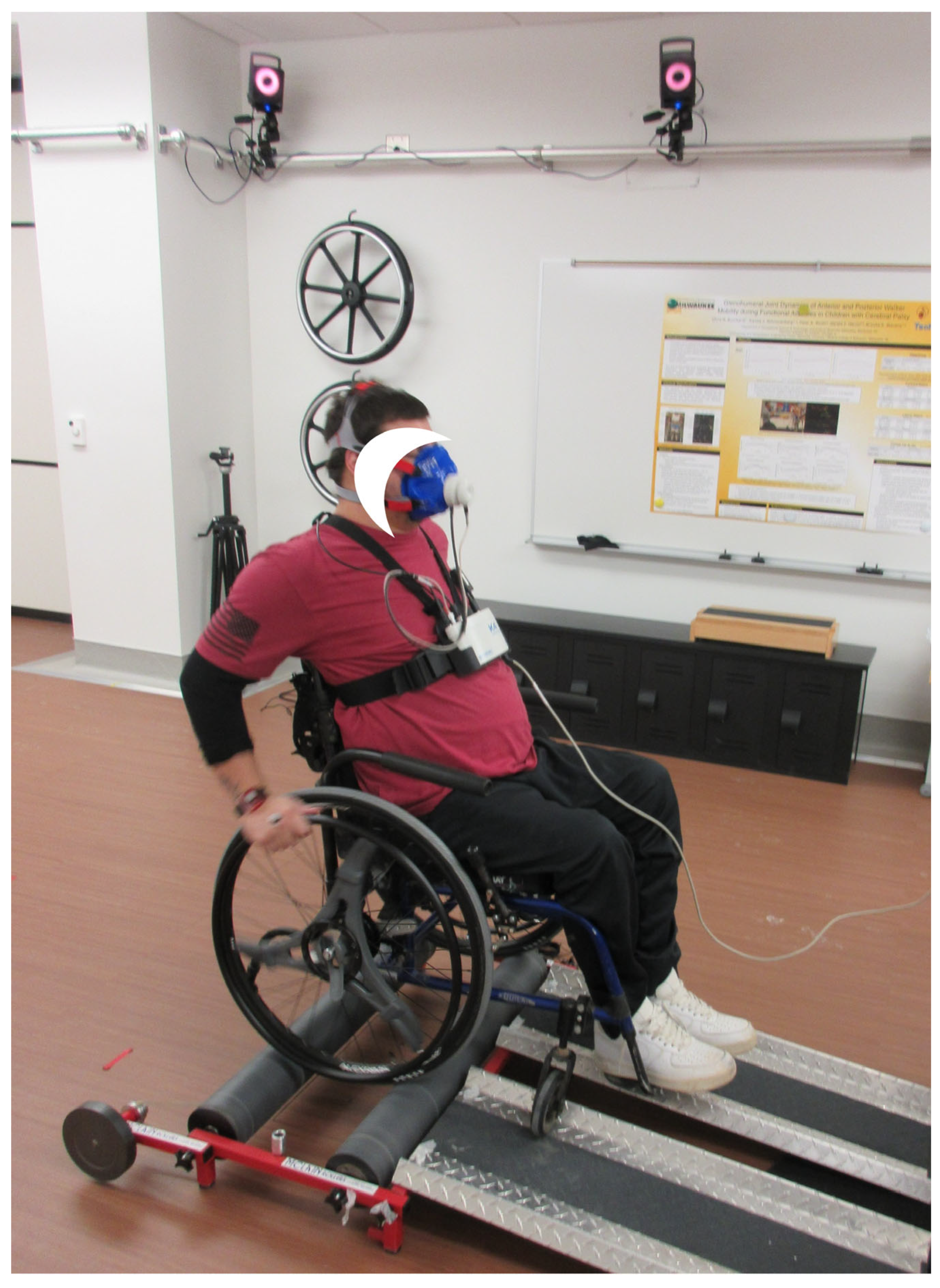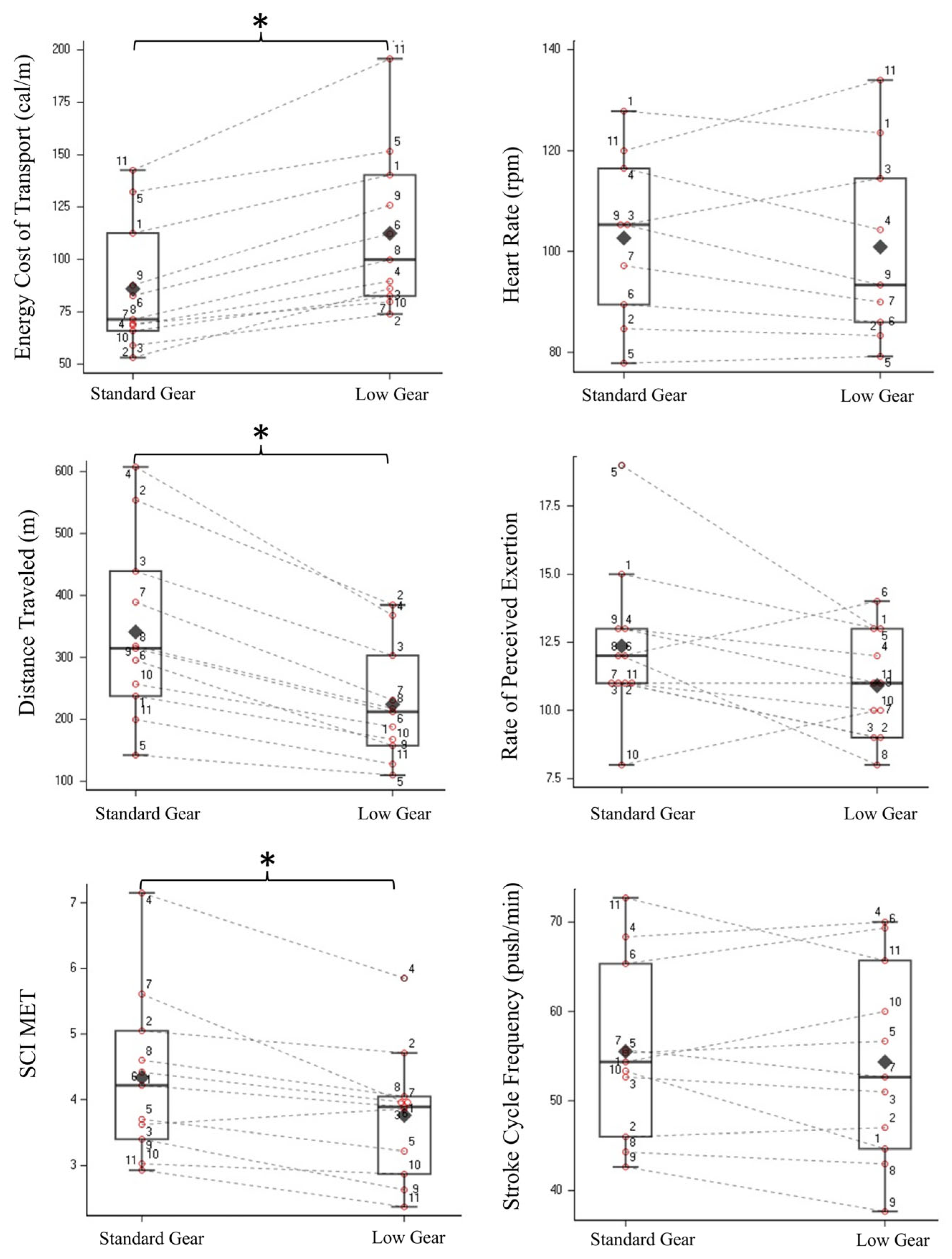The Effects of Using Geared Wheels on Energy Expenditure During Manual Wheelchair Propulsion in Adults with Spinal Cord Injury
Abstract
1. Introduction
2. Methods
2.1. Participants
2.2. Experimental Protocol and Instrumentation
2.3. Data Processing
2.4. Statistical Analysis
3. Results
4. Discussion
5. Conclusions
Author Contributions
Funding
Institutional Review Board Statement
Informed Consent Statement
Data Availability Statement
Conflicts of Interest
References
- Taylor, D.M. Americans with Disabilities: 2014; US Census Bureau: Washington, DC, USA, 2018; pp. 1–32. [Google Scholar]
- Beekman, C.E.; Miller-Porter, L.; Schoneberger, M. Energy cost of propulsion in standard and ultralight wheelchairs in people with spinal cord injuries. Phys. Ther. 1999, 79, 146–158. [Google Scholar] [CrossRef] [PubMed]
- Stover, S.L.; DeLisa, J.A.; Whiteneck, G.G. Spinal Cord Injury: Clinical Outcomes from the Model Systems; Aspen Publishers: Burlington, MA, USA, 1995. [Google Scholar]
- Waters, R.L.; Lunsford, B. Energy cost of paraplegic locomotion. J. Bone Jt. Surg. Am. Vol. 1985, 67, 1245–1250. [Google Scholar] [CrossRef]
- Cerny, K.; Waters, R.; Hislop, H.; Perry, J. Walking and wheelchair energetics in persons with paraplegia. Phys. Ther. 1980, 60, 1133–1139. [Google Scholar] [CrossRef] [PubMed]
- Sawka, M.N.; Glaser, R.M.; Wilde, S.W.; Von Luhrte, T.C. Metabolic and circulatory responses to wheelchair and arm crank exercise. J. Appl. Physiol. 1980, 49, 784–788. [Google Scholar] [CrossRef]
- van der Woude, L.H.; de Groot, S. Wheelchair propulsion: A straining form of ambulation. Indian J. Med. Res. 2005, 121, 719. [Google Scholar]
- Mukherjee, G.; Bhowmik, P.; Samanta, A. Effect of chronic use of different propulsion systems in wheelchair design on the aerobic capacity of Indian users. Indian J. Med. Res. 2005, 121, 747. [Google Scholar]
- Howarth, S.J.; Pronovost, L.M.; Polgar, J.M.; Dickerson, C.R.; Callaghan, J.P. Use of a geared wheelchair wheel to reduce propulsive muscular demand during ramp ascent: Analysis of muscle activation and kinematics. Clin. Biomech. 2010, 25, 21–28. [Google Scholar] [CrossRef]
- Jahanian, O.; Gaglio, A.; Cho, C.C.; Muqeet, V.; Smith, R.; Morrow, M.M.B.; Hsiao-Wecksler, E.; Slavens, B.A. Hand-rim biomechanics during geared manual wheelchair propulsion over different ground conditions in individuals with spinal cord injury. J. Biomech. 2022, 142, 111235. [Google Scholar] [CrossRef]
- Jahanian, O.; Gaglio, A.; Schnorenberg, A.J.; Muqeet, V.; Hsiao-Wecksler, E.T.; Slavens, B.A. Evaluation of hand-rim and wrist joint kinetics during geared manual wheelchair propulsion in veterans with spinal cord injury. Biomed. Sci. Instrum. 2019, 55, 324–329. [Google Scholar]
- Jahanian, O.; Schnorenberg, A.J.; Muqeet, V.; Hsiao-Wecksler, E.T.; Slavens, B.A. Glenohumeral joint dynamics and shoulder muscle activity during geared manual wheelchair propulsion on carpeted floor in individuals with spinal cord injury. J. Electromyogr. Kinesiol. 2022, 62, 102318. [Google Scholar] [CrossRef]
- Slavens, B.A.; Jahanian, O.; Schnorenberg, A.J.; Hsiao-Wecksler, E.T. A comparison of glenohumeral joint kinematics and muscle activation during standard and geared manual wheelchair mobility. Med. Eng. Phys. 2019, 70, 1–8. [Google Scholar] [CrossRef] [PubMed]
- Finley, M.A.; Rodgers, M.M. Effect of 2-speed geared manual wheelchair propulsion on shoulder pain and function. Arch. Phys. Med. Rehabil. 2007, 88, 1622–1627. [Google Scholar] [CrossRef] [PubMed]
- McLaughlin, J.; King, G.; Howley, E.; Bassett, D., Jr.; Ainsworth, B. Validation of the COSMED K4 b2 portable metabolic system. Int. J. Sports Med. 2001, 22, 280–284. [Google Scholar] [CrossRef]
- Collins, E.G.; Gater, D.; Kiratli, J.; Butler, J.; Hanson, K.; Langbein, W.E. Energy cost of physical activities in persons with spinal cord injury. Med. Sci. Sports Exerc. 2010, 42, 691–700. [Google Scholar] [CrossRef] [PubMed]
- Borg, G. Borg’s Perceived Exertion and Pain Scales; Human Kinetics: Champaign, IL, USA, 1998. [Google Scholar]
- Goosey-Tolfrey, V.; Lenton, J.; Goddard, J.; Oldfield, V.; Tolfrey, K.; Eston, R. Regulating Intensity Using Perceived Exertion in Spinal Cord-Injured Participants; Lippincott Williams and Wilkins: Philadelphia, PA, USA, 2010. [Google Scholar]
- Ward, D.S.; Bar-Or, O.; Longmuir, P.; Smith, K. Use of Rating of Perceived Exertion (RPE) to prescribe exercise intensity for wheelchair-bound children and adults. Pediatr. Exerc. Sci. 1995, 7, 94–102. [Google Scholar] [CrossRef]
- Elia, M.; Livesey, G. Energy expenditure and fuel selection in biological systems: The theory and practice of calculations based on indirect calorimetry and tracer methods. In Metabolic Control of Eating, Energy Expenditure and the Bioenergetics of Obesity; Karger Publishers: Basel, Switzerland, 1992; Volume 70, pp. 68–131. [Google Scholar]
- Lenton, J.; Van der Woude, L.; Fowler, N.; Nicholson, G.; Tolfrey, K.; Goosey-Tolfrey, V. Hand-rim forces and gross mechanical efficiency at various frequencies of wheelchair propulsion. Int. J. Sports Med. 2013, 34, 158–164. [Google Scholar] [CrossRef]
- Van der Woude, L.; Veeger, H.; Rozendal, R.; Sargeant, A. Optimum cycle frequencies in hand-rim wheelchair propulsion. Eur. J. Appl. Physiol. Occup. Physiol. 1989, 58, 625–632. [Google Scholar] [CrossRef]
- Salm, L.; Schreff, L.; Benker, C.; Abel, R.; Müller, R. The effect of a cognitive dual-task on the control of wheelchair propulsion. PLoS ONE 2025, 20, e0317504. [Google Scholar] [CrossRef]
- Haskell, W.L.; Lee, I.-M.; Pate, R.R.; Powell, K.E.; Blair, S.N.; Franklin, B.A.; Macera, C.A.; Heath, G.W.; Thompson, P.D.; Bauman, A. Physical activity and public health: Updated recommendation for adults from the American College of Sports Medicine and the American Heart Association. Med. Sci. Sports Exerc. 2007, 39, 1423–1434. [Google Scholar] [CrossRef]
- Rice, I.M.; Jeng, B.; Silveira, S.L.; Motl, R.W. Push-rate threshold for physical activity intensity in persons who use manual wheelchairs. Am. J. Phys. Med. Rehabil. 2021, 100, 292–296. [Google Scholar] [CrossRef]
- Fernhall, B.; Heffernan, K.; Jae, S.Y.; Hedrick, B. Health implications of physical activity in individuals with spinal cord injury: A literature review. J. Health Hum. Serv. Adm. 2008, 30, 468–502. [Google Scholar] [CrossRef]
- Blair, S.N.; Jackson, A.S. Physical fitness and activity as separate heart disease risk factors: A meta-analysis. Med. Sci. Sports Exerc. 2001, 33, 754. [Google Scholar] [CrossRef]


| Participant | Age (Years) | Weight (kg) | Height (cm) | Arm Dominance | SCI Level | Years as Wheelchair User |
|---|---|---|---|---|---|---|
| 1 | 53 | 87 | 178 | Left | T4, ASIA A | 27 |
| 2 | 42 | 85 | 188 | Right | T10, ASIA C | 21 |
| 3 | 55 | 98 | 185 | Right | T5, ASIA A | 31 |
| 4 | 36 | 80 | 175 | Right | L2, ASIA C | 12 |
| 5 | 68 | 73 | 170 | Right | T10, ASIA A | 1.5 |
| 6 | 57 | 81 | 180 | Right | T11, ASIA C | 0.6 |
| 7 | 50 | 66 | 180 | Right | T6, ASIA C | 9.5 |
| 8 | 24 | 71 | 180 | Right | T5, ASIA A | 2 |
| 9 | 51 | 112 | 188 | Left | T12, ASIA C | 30 |
| 10 | 29 | 93 | 188 | Right | T1, ASIA A | 10 |
| 11 | 54 | 136 | 193 | Right | T12, ASIA A | 36 |
| Mean (SD) | 47.2 (13.1) | 89 (20) | 182.3 (6.8) | -------------- | ------------ | 16.4 (13.1) |
| Marker | Location |
|---|---|
| M3 | Dorsal aspect of the hand on the third metacarpal joint, dominant side |
| Wrist | Dorsal aspect of the wrist midway between the radial and ulnar styloid processes, dominant side |
| Wheel | Center of wheel hub, non-dominant side |
| Off-Center | On the wheel, at a distance of 15 cm from the center of the wheel hub, non-dominant side |
| Standard Gear | Geared | Statistical Results | ||||||
|---|---|---|---|---|---|---|---|---|
| Mean (SD) | Median (Q1, Q3) | Mean (SD) | Median (Q1, Q3) | N | Z | p | r | |
| CT (cal/m) | 85.9 (30.1) | 71.4 (67.2, 100.1) | 112.5 (37.8) | 99.9 (84.4, 133.1) | 11 | 2.93 | 0.003 * | 0.62 |
| Distance (m) | 341.1 (144.6) | 314.3 (247.2, 413.9) | 224.1 (91.8) | 212.1 (162.2, 266.9) | 11 | 2.93 | 0.003 * | 0.62 |
| SCI MET | 4.3 (1.2) | 4.2 (3.5. 4.8) | 3.8 (1.0) | 3.9 (3.0, 4.0) | 11 | 2.75 | 0.006 * | 0.59 |
| HR (bpm) | 102 (16) | 105.3 (89.5, 116.5) | 100 (19) | 93.3 (86.0, 114.5) | 9 | 0.71 | 0.47 | 0.17 |
| RPE | 12.4 (2.8) | 12.0 (11.0, 13.0) | 10.9 (1.9) | 11.0 (9.5, 12.5) | 11 | 1.72 | 0.085 | 0.37 |
| Frequency (push/min) | 55 (9) | 54.3 (49.3, 60.5) | 54 (10) | 52.7 (45.8, 62.8) | 11 | 0.76 | 0.45 | 0.16 |
Disclaimer/Publisher’s Note: The statements, opinions and data contained in all publications are solely those of the individual author(s) and contributor(s) and not of MDPI and/or the editor(s). MDPI and/or the editor(s) disclaim responsibility for any injury to people or property resulting from any ideas, methods, instructions or products referred to in the content. |
© 2025 by the authors. Licensee MDPI, Basel, Switzerland. This article is an open access article distributed under the terms and conditions of the Creative Commons Attribution (CC BY) license (https://creativecommons.org/licenses/by/4.0/).
Share and Cite
Jahanian, O.; Silver-Thorn, B.; Muqeet, V.; Hsiao-Wecksler, E.T.; Slavens, B.A. The Effects of Using Geared Wheels on Energy Expenditure During Manual Wheelchair Propulsion in Adults with Spinal Cord Injury. Biomechanics 2025, 5, 80. https://doi.org/10.3390/biomechanics5040080
Jahanian O, Silver-Thorn B, Muqeet V, Hsiao-Wecksler ET, Slavens BA. The Effects of Using Geared Wheels on Energy Expenditure During Manual Wheelchair Propulsion in Adults with Spinal Cord Injury. Biomechanics. 2025; 5(4):80. https://doi.org/10.3390/biomechanics5040080
Chicago/Turabian StyleJahanian, Omid, Barbara Silver-Thorn, Vaishnavi Muqeet, Elizabeth T. Hsiao-Wecksler, and Brooke A. Slavens. 2025. "The Effects of Using Geared Wheels on Energy Expenditure During Manual Wheelchair Propulsion in Adults with Spinal Cord Injury" Biomechanics 5, no. 4: 80. https://doi.org/10.3390/biomechanics5040080
APA StyleJahanian, O., Silver-Thorn, B., Muqeet, V., Hsiao-Wecksler, E. T., & Slavens, B. A. (2025). The Effects of Using Geared Wheels on Energy Expenditure During Manual Wheelchair Propulsion in Adults with Spinal Cord Injury. Biomechanics, 5(4), 80. https://doi.org/10.3390/biomechanics5040080






